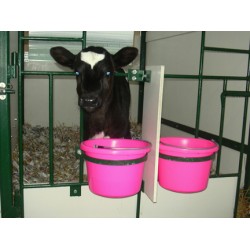APT, or Acoustic Pulse Technology
WHAT IS ACOUSTIC PULSE TECHNOLOGY?
It is the local transmission of mechanical energy through soundwaves, by using a device that is applied to the outside skin of the udder. APT sound waves are applied to the udder in 3 applications, usually three days apart. Each application takes approximately three minutes.
HOW DOES ACOUSTIC PULSE TECHNOLOGY WORK IN MASTITIS?
One research paper states "APT involves the local transmission of mechanical energy through soundwaves which stimulate anti-inflammatory and angiogenic responses in the udder. These responses promote udder recovery and enhance resistance to bacterial infections." https://www.frontiersin.org/articles/10.3389/fvets.2023.1079269/full
DOES ACOUSTIC PULSE TECHNOLOGY WORK IN DAIRY COW MASTITIS?
Here is a research article-
Assessment of acoustic pulse therapy (APT), a non-antibiotic treatment for dairy cows with clinical and subclinical mastitis
https://journals.plos.org/plosone/article?id=10.1371/journal.pone.0199195
Authors- Gabriel Leitner1 *, David Zilberman2 , Eduard Papirov3 , Sela Shefy3
1 National Mastitis Reference Center, Kimron Veterinary Institute, Bet Dagan, Israel,
2 Department of Agricultural and Resource Economics, University of California, Berkeley, United States of America,
3 HIImpacts, Raanana, Israel
Summary of this research paper-
A) 116 cows with sub-clinical mastitis split into 78 Acoustic Pulse group & 38 ‘no treatment control group’ cows
"The major benefit was demonstrated by treating subclinical mastitis during lactation. Because no negative effects on milk yield and other milk parameters were observed, cows were milked normally during treatment, so no loss of milk accrued. Only 18.4% of the control cows that were identified with subclinical infection but were not treated, returned to producing normal milk. However, only 60% of E. coli infections, 18.2% of Streptococci and 13.3% of CNS were cured without intervention. In contrast, when applying the APT treatment, 70.5% of the cows were cured and returned to producing normal milk with a significant increase in milk yield. Moreover, quarters of treated cows with identified bacteria had a bacterial cure of 52.6%"
So, in subclinical mastitis- 18.4% successon the no-treatment/controls, APT application resulted in 70.5% success.
B) 29 cows with clinical mastitis.
13 cows received Acoustic Pulses. 77% logSCC went below 5.6cell/ml & 1 cow culled,
16 cows received antibiotic treatment. 19% cured & 9 culls.
The results revealed a higher cure of the bacteria, a faster return to milking into the bulk milk tank and to the level of SCC as prior to the infection incident, as well as lower culling than that of treating with antibiotics.
The new APT treatment of clinical and subclinical mastitis can:
1. potential significant reduction in the use of antibiotics;
2. significantly reduce milk discarding during treatment;
3. can be used to treat subclinical mastitis during lactation;
4. improve milk quantity and quality during the lactation, probably due to the increased healing process of the damaged tissues;
5. decrease culling of subclinical mastitis cows due to low milk production and low milk quality.
APT is already in use in 12 countries. How will APT be deployed in the UK?
Watch this space!




